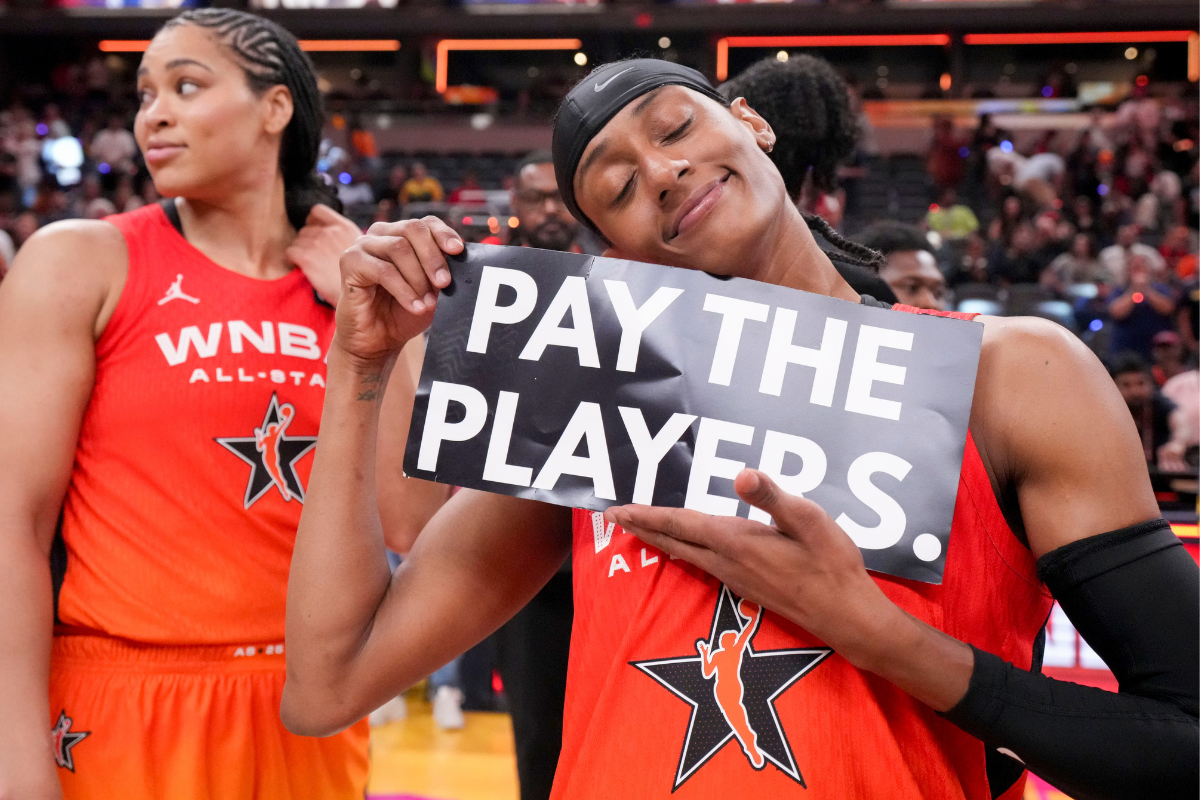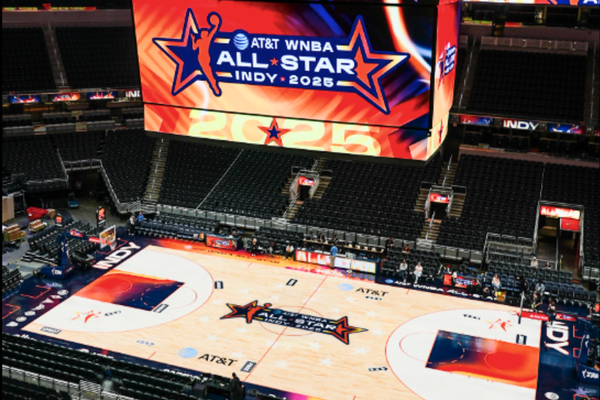
USA Today via Reuters
Image credits: USA Today

USA Today via Reuters
Image credits: USA Today
The 2025 WNBA All-Star Game had all the makings of a thrilling night—Caitlin Clark’s replacement making headlines, Napheesa Collier steering Team Collier to victory—but none of that was the real story. Before the ball even tipped, players made their message crystal clear. Ditching designer tunnel fits for bold black warm-up shirts, every athlete walked in wearing five powerful words: “Pay Us What You Owe Us.” This wasn’t just fashion. It was a protest, a purpose, and a unity wrapped in one powerful visual.
Watch What’s Trending Now!
Does the NBA subsidize the WNBA?
It all started with an idea—a bold one. In 1996, the NBA’s Board of Governors approved a proposal to launch a women’s professional basketball league. A year later, the WNBA tipped off its very first season. David Stern, then NBA commissioner, had a vision: a league that could showcase the incredible talent of women athletes on a national stage. At the time, the American Basketball League (ABL) was already operating, but by 1998, the WNBA had pushed it out of business. A monopoly was formed, and for a while, all WNBA teams were owned by the NBA itself. It was a fresh start. But it wasn’t an easy one.
ADVERTISEMENT
From day one, the WNBA faced steep hills to climb. The games were fast-paced, the talent undeniable, but the target audiences and market size were way lower. And let’s not talk bout the money being invested in a women’s league at the time. Poor TV ratings and half-empty arenas became the norm. By 2018, it was confirmed that the league had never turned a profit since its debut in 1997. The excitement on the court wasn’t translating into revenue off it. The product was there. The support? Not so much. Still, the league held on—largely thanks to one very consistent force: the NBA, a multi-billion-dollar league.
The NBA never let go of the WNBA’s hand. Even now, WNBA team owners hold only 42% of the league, the NBA owns another 42%, and the remaining 16% belongs to investors from a $75 million capital raise in 2022. But here’s the kicker: six of the WNBA’s 14 franchises are owned by NBA team owners, so technically, NBA owners directly control more than 60% of the WNBA.
Top Stories
‘RIP’: NASCAR World Crumbles in Tears as 39-YO Former JR Motorsports Driver Passes Away

Bills Announce Historic Josh Allen News Before Bengals Game

Ravens’ Lamar Jackson Demands Short-Term Contract Away From NFL on Thursday

Chiefs Veteran Gives Up on Playoff Hopes With Patrick Mahomes & Travis Kelce Facing the Impossible

Lamar Jackson Has Reportedly Been Seeking John Harbaugh’s Firing for Years as Locker Room Secret Leaked

Donald Trump Takes Unexpected Shot at NFL With Name Change Call During FIFA World Cup Draw

Atlanta Dream CEO Suzanne Abair summed it up perfectly when she said, “If all the WNBA owners say they want to do something and the NBA says no, the answer is no.” So, whether it’s player pay or league decisions, it’s NBA owners who have the final say. Hence, the critics call the WNBA a subsidy. Supporters call it an investment. Either way, the NBA’s role is clear—without its backing, the WNBA would be fighting a much harder battle. And NBA Commissioner Adam Silver knows that, too.
ADVERTISEMENT
Back in 2018, when WNBA players decided to opt out of their collective bargaining agreement, Silver didn’t flinch. “I wasn’t disappointed at all,” he said in an interview with ESPNW. Instead of resistance, he offered an open door. He admitted there was a disconnect between the players and the league and promised to fix that. To him, this wasn’t just about contracts—it was about connection. And more than anything, his words reminded everyone of one thing: the NBA isn’t just watching the WNBA from a distance. It’s standing right beside it.
ADVERTISEMENT
How Does the NBA Support the WNBA?
According to AS.com, the NBA currently subsidizes the WNBA with approximately $15 million annually to help cover critical costs like operations, marketing, player salaries, and facilities. NBA commissioner Adam Silver has been transparent about this ongoing support, saying, “We’ve invested year after year and are going to continue to invest… There is no short-term business plan to turn the league into a profitable one, but that’s OK.” Beyond finances, the NBA shares facilities, promotes WNBA content through NBA TV, and often steps in to secure major sponsorships. The NBA even owns 60% of the WNBA—underscoring how deeply intertwined the two leagues are.
And when it comes to media rights, the support gets even bigger. Just this year, the NBA signed a massive $75 billion media deal with Disney, NBCUniversal, and Amazon, and the WNBA got a cut—$2.2 billion over 11 years, or roughly $200 million a year. While some critics felt the WNBA might’ve earned more negotiating separately, Silver defended the joint approach, telling CNBC, “Should we collectively have gone out and had separate discussions around the WNBA? I would say, in essence, we did… Could we have done even better than that? I’m not sure.”
WNBA commissioner Cathy Engelbert echoed this strategy, saying, “We need the NBA because we have a smaller footprint with only 40 games, and it’s nice to go to market together.” Yet others, like Cheryl Miller, called the NBA’s assigned value low, saying, “That’s a low-ball… ($2 billion) is nice, ($8 billion) would be better.”
ADVERTISEMENT
Still, this isn’t a debate about equal pay—it’s about equal stakes. As Kelsey Plum put it plainly, “I’m tired of people thinking that (we) players are asking for the same type of money as NBA players… we are asking for the same percentage of revenue shared within our CBA. NBA players receive around 50% of shared revenue within their league, whereas we receive around 20%.”
So, while the NBA’s backing has helped elevate the WNBA onto national stages—like All-Star Weekend and WNBA Finals promotions—the call from players is clear: they don’t want charity; they want equity. And with the WNBA’s current media deal expected to climb as high as $3 billion, the conversation is shifting fast. As ESPN reported, that deal—spanning CBS Sports, Scripps Sports’ Ion, and more—could take annual revenue to over $272 million, more than four times its previous amount. Growth is happening. But is it absolute or relative?
ADVERTISEMENT
Does the WNBA Make Money?
The WNBA has been riding a wave of historic visibility, booming fan engagement, and landmark investments. Between Caitlin Clark’s electrifying college run, the NIL explosion, and a record-breaking 9.92 million viewers tuning into the 2023 NCAA March Madness final, women’s basketball in this country is finally getting its spotlight moment.
The WNBA followed that momentum with a massive $75 million capital raise in 2022—the largest ever for a women’s sports property—with investors like Nike, Michael Dell, and Laurene Powell Jobs. “Thanks to this capital raise, we’re going to take a huge step forward in our growth strategy, particularly in areas like player marketing and elevating everything we do with our fans,” Commissioner Cathy Engelbert announced on CNBC.

Imago
Unlicensed image
But even with that success, the league is still not profitable. Despite surging media deals—like the $39 million three-year deal with Scripps and existing ESPN contracts running until 2025—the WNBA is “still expected to lose $40 million this season.” NBA Commissioner Adam Silver has been candid about the uphill battle, saying, “The tickets [of the WNBA] are very inexpensive, but even at low prices, we’re not selling enough tickets to run a viable business.” He added, “In essence, we’ve incurred 70 percent of those losses over the last 22 years of operating the league.”
While the WNBA has made massive strides—viewership up 49% in 2021 compared to 2020, and a new CBA increasing player salaries by 60%—the league still leans on NBA subsidies to survive. As Silver put it, “The investment that we have made over the last 22 years in the WNBA is many times greater than the investment we’ve made in the G League.” The business model is evolving, but for now, the NBA’s support is the backbone keeping it afloat.
The WNBA has come a long way since 1996 — from a league fully owned by the NBA to one sharing ownership with investors and independent team owners. The league’s reach and revenue have grown, thanks to rising stars, stronger media deals, and a new wave of fans. But despite this growth, the NBA continues to subsidize the WNBA, both financially and operationally. Whether it’s covering losses, securing sponsorships, or sharing facilities, the NBA’s backing remains a pillar of the WNBA’s existence. And while the hope is for the WNBA to one day thrive on its own, for now, it’s clear that the NBA’s support is not just helpful — it’s essential for the league’s future.
ADVERTISEMENT
ADVERTISEMENT
ADVERTISEMENT

